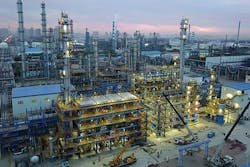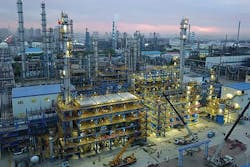Chinese refiners ramp up alkylation capacity
Robert Brelsford
Downstream Technology Editor
China’s refiners are increasing alkylation capacity to produce lower-sulfur, higher-octane alkylate. Greater volumes of alkylate are needed to ensure China’s gasoline and diesel production comply with more stringent global emission standards, including China 6-quality specifications (equivalent to Euro 6 specifications), which will cap the maximum sulfur content of fuels at 10 ppm beginning in 2020.
Alongside traditional alkylation units, PetroChina Co. Ltd.—the publicly listed arm of state-owned China National Petroleum Corp. (CNPC)—and China Petroleum & Chemical Corp. (Sinopec) are installing new units based on an ionic liquid (IL) alkylation process, or ionikylation, previously proved on pilot and commercial-scales in China as part of both retrofit of a sulfuric acid alkylation unit and construction of a grassroots unit.
In November 2018, PetroChina Co. Ltd.—the publicly listed arm of state-owned China National Petroleum Corp. (CNPC)—commissioned a new 3,000-b/d alkylation unit based on ionikylation technology at subsidiary Harbin Petrochemical Co. Ltd.’s refinery in Harbin City, Heilongjiang Province, China. Photo from CNPC.
Novel technology
Recent implementation of a policy by China’s Environmental Protection Agency to impose heavy penalties on operators who engage or are complicit in industrial safety violations has prompted many refinery owners and managers in the country to adopt alternative, safer technologies that can be applied throughout their operations.
Traditional alkylation processes require the presence of strong acids such as hydrofluoric acid and concentrated sulfuric acid as catalyst. Chinese refiners have turned their attention to Beijing-based China University of Petroleum’s (CUP) ionikylation process, which uses a more selective composite IL catalyst than other IL alkylation processes.
Licensed by Well Resources Inc., Calgary, ionikylation uses a proprietary composite IL as the catalyst to produce alkylates meeting or exceeding the quality of those produced using more traditional means. While ionikylation process operating conditions (ambient temperatures and moderate pressures) and operating costs are comparable to traditional alkylation processes, ionikylation has a higher yield and selectivity towards formation of more valuable, high-octane compounds such as trimethylpentanes than do traditional alkylation processes.
The noncorrosive nature of the ionikylation catalyst allows process equipment to be manufactured using low-cost carbon steel instead of stainless steel or other exotic metallurgies required by traditional alkylation processes. Further, unlike traditional processes (which consume large quantities of anhydrous hydrofluoric acid and sulfuric acid catalysts requiring costly, specialized treatment), ionikylation catalyst is recycled and regenerated within the process, leaving only a small volume of chemically benign spent catalyst and solids to be safely and easily disposed.
PetroChina first used ionikylation in 2005 with a retrofit of an existing 65,000-tonne/year sulfuric acid alkylation unit at one of its refineries (OGJ, Oct. 23, 2006, p. 52). The unit continued to run cyclically for about 3 years until changes in C4-feedstock pricing made ongoing operation economically unappealing, an individual familiar with the project told OGJ.
Chinese independent refiner Deyang Chemical Co. Ltd. also subsequently selected ionikylation for construction of a grassroots alkylation unit at its plant in Dongying Economic Development Zone, Dongying City, Shandong Province. Intended to help meet increased demand for cleaner motor fuels both in China and abroad, the 2,000-b/d ionikylation unit was commissioned in 2013 and remains in operation today, according to descriptions on Deyang Chemical and CUP’s web sites.
Ionikylation projects
On Nov. 4, 2018, PetroChina subsidiary Harbin Petrochemical Co. Ltd. commissioned a 3,000-b/d alkylation unit at its refinery in Harbin City, Heilongjiang Province. The new alkylation unit—the first of its kind in CNPC’s refining system to be based on ionikylation—uses the IL alkylation process to produce high-quality isooctane products from a C4 liquified-gas feedstock and improve vehicle fuel standards and urban air quality in the region, PetroChina said.
Alkylated gasoline produced by the unit has the advantages of high-octane number, low-sulfur content, olefin-free aromatics, high oil yield, and good economic efficiency, according to the operator.
Implemented by CNPC Northeast Refining & Chemical Engineering Co. Ltd., Harbin Petrochemical’s new unit is the first of 10 planned ionikylation units to be built and commissioned in PetroChina and Sinopec refineries during the next 2 years, according to an industry source familiar with the projects.
In late October 2018, Sinopec confirmed it is proceeding with plans to implement new 6,000-b/d ionikylation units at subsidiaries Sinopec Jiujiang Co.’s 161,000-b/d refinery in Jiujiang City, Jiangxi Province, Sinopec Anqing Co.’s 161,000-b/d refinery in Anqing, Anhui Province, and Wuhan Petrochemical Co. Ltd.’s 161,000-b/d refinery in Wuhan City, Hubei Province. Precise timeframes for project implementation at these refineries, however, have yet to be disclosed.
Other projects
While Chinese refiners are increasingly adopting ionikylation as their preferred alkylation process, some of these same refiners continue to adopt previously established forms of the technology for their plants.
In late 2017, Sinopec let a contract to DuPont Clean Technologies to deliver technology licensing, engineering, and equipment for two of its proprietary STRATCO alkylation units to be installed at Yangzi Petrochemical Co.’s 281,000-b/d refinery at Nanjing, Jiangsu Province, and Zhenhai Refining & Chemical Co.’s 462,000-b/d refinery at Ningbo City, Zhejiang Province (OGJ Online, Dec. 5, 2017).
The contract follows previous awards to DuPont for another three units at Sinopec subsidiaries Qilu Petrochemical Corp.’s 281,000-b/d refinery at Zibo, Shandong Province; Tianjin Co.’s 277,000-b/d integrated complex at Tianjin Binhai New Area, Tianjin; and the Sinopec-Kuwait Petroleum Corp. (KPC) 300,000-b/d planned Sino-Kuwait integrated complex under construction on Donghai Island of Zhanjiang City in China’s Guangdong Province (OGJ Online, Nov. 10, 2017; Aug. 25, 2017; Jan. 26, 2017).
Sinopec said these new alkylation units come as part of the operator’s broader plan to produce low-sulfur, high-octane, low-RVP alkylate to help ensure compliance with China 5 emission standards that, equivalent to Euro 5 specifications, cap the maximum sulfur content of gasoline and diesel at 10 ppm as well as even stricter China 6 emission standards scheduled to be adopted by July 2020. The new units tentatively were scheduled for startup by yearend 2018.
PetroChina also has secured more traditional alkylation technology from McDermott International Inc. (formerly CB&I) to outfit grassroots units at several of its refineries. In 2017, the operator contracted McDermott to provide technology licensing, engineering design, and patented equipment for the new units based on CDAlky advanced sulfuric acid alkylation process technology (OGJ Online, Aug. 28, 2017).
Intended to help the operator ensure compliance of gasoline and diesel production with more stringent global emission standards, including China 6-quality specifications, single units are scheduled for installation before 2020 at four of PetroChina’s refineries, including subsidiaries Dalian Petrochemical Co.’s 412,000-b/d Dalian refinery in Liaoning Province, Jilin Petrochemical Co.’s 201,000-b/d Jilin City refinery in Jilin Province, Jinzhou Petrochemical Co.’s 141,000-b/d Jinzhou refinery in Liaoning Province, and Urumqi Petrochemical Co.’s 100,400-b/d Urumqi refinery in Xinjiang Uygar Autonomous Region.

